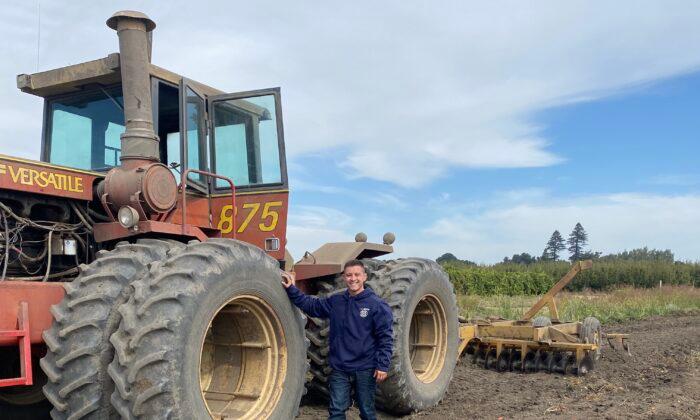Alex Wilson is a sixth-generation California farmer, growing fruits and grain in a state that has been severely affected by an ongoing water shortage. At age 27, he’s the youngest member to continue the family tradition of farming in the Sacramento-San Joaquin Delta region.
Through the years, Wilson’s family has survived periods of drought and flooding while growing pears, cherries, tomatoes, wheat, alfalfa, and other crops on their 4,000 acres in Yolo, Sacramento, and San Joaquin counties.
This year, the family found another way to help conserve water: through the state-funded Delta Drought Response Pilot Project.
“I saw an email that had come out where the state was basically willing to pay a farmer not to irrigate,” Wilson said. “It kind of caught my attention.”
Wilson and his uncle applied and were accepted into the state program, proposing to grow safflower on a parcel of land called Dead Horse Island in Walnut Grove, located more than an hour east of San Francisco. Safflower, used for vegetable oil, conserves water because it doesn’t require irrigation to grow.

Through the state program, the Wilson family planted the crop along the San Joaquin River Delta in Sacramento County and was paid $900 per acre on 185 acres, yielding 277 tons.
“As long as you plant the safflower seed when the ground has moisture, then you’re able to germinate the seed and thus grow a crop,” Wilson said.
The plant is a good option to grow after harvesting tomatoes every two years, he said. Many farmers grow tomatoes or corn and then, in the third year, plant wheat or something similar to give the soil a break.
In the early 1900s, Dead Horse Island was a sprawling sanctuary for retired working horses who were sent to the island by their owners to live out their final days. The Wilson family has grown cherries and pears on the land for years but switched to other types of crops that can better resist floods after the river levee broke in 1986 and 1997.

The drought program, led by the Sacramento-San Joaquin Delta Conservancy, in partnership with the Department of Water Resources, the Office of the Delta Watermaster, and The Nature Conservancy, appears to have been successful in improving water conditions, according to Michael George, Delta water master for the California State Water Resources Control Board.
“We did get water conservation savings,” George told The Epoch Times. “We did prevent that water from being put to a different use.”
Results aren’t yet final for the first year of the program, which ended on Sept. 30. A total of 34 participants were accepted out of the 84 that applied, representing about 8,800 acres.
The program included a good variety of crops, and preliminary data show water savings, according to George.
The saved water added a buffer to the river, improving water quality in the Delta, he said.
“We did get through the year without as much salinity intrusion, for instance, as we had the prior year,” George said.
Salinity intrusion is the influx of seawater into a river delta when there’s less freshwater flowing toward the ocean.
The program’s 8,800 acres represent a small portion of the 500,000 acres of farmland in the Delta—an area that’s roughly the size of Rhode Island.
The state asked farmers to propose the practices that they would recommend with the objective of conserving water and preventing salty water from entering the Delta. By doing that, the state hopes to preserve wildlife habitats, according to George.
“Drought is experienced not as a lack of physical water, but as a threat to the water quality,” he said. “Because if there’s not sufficient freshwater flow in the rivers that feed the Delta, you can have the incursion of saltwater from Suison Marsh and San Pablo Bay.”

This year, California experienced another year of extreme drought with historically dry months and a record-shattering heatwave, according to California Water Watch. The state ended its water year on Sept. 30, receiving only 76 percent of its average precipitation and 69 percent of its average water storage.
The persistent drought conditions and low water storage prompted the state to renew the pilot program for next year, according to George.
The program has also enabled farmers and state water officials to learn from each other.
“What we found universally was that the farmers who were in the program were as eager as the state agencies to learn what works ... in different places,” George said.
For 2023, instead of a flat rate-per-acre offer, farmers submitted bids for consideration by the state. In total, 125 applicants submitted bids by the deadline of Oct. 18, according to the state water board.
Those are now being reviewed, a spokeswoman from the water board told The Epoch Times.
So far, cannabis growers haven’t participated in the program, electing to not apply for the 2022 year. The state doesn’t yet know if any have submitted bids for the 2023 program.

The Wilson family submitted two bids for next year’s program, with a plan to grow 380 acres of wheat, Wilson said.
It’s a gamble, he noted. He needs to plant the wheat when the soil still has moisture so the seed can germinate. If his fields don’t get winter rain, he could be staring at a loss.
Whether his proposals are accepted or not this time, Wilson said, “I do think I made the right decision [to plant wheat] for the soil and for saving water.”
Planting wheat made sense in the current economic conditions. Farmers face higher costs to grow crops but, with inflation, they’re also getting higher prices at the market.
Growing wheat can be profitable now, he said, also because it qualifies for the state’s water conservation program.
“At the heart of it, farmers are also businessmen. If they are able to return a higher per-acre return on their crop by not irrigating through a state program, then it makes it a very attractive program to participate in,” Wilson said. “You have to do what’s best for the soil, but we also have to do what’s best for our business.”
The program has been phenomenal, he said. Many of the Walnut Grove-area farmers who attended a meeting about it left wanting to apply.
One state water official, Darcy Burke, president of Elsinore Valley Municipal Water District, told The Epoch Times that she was skeptical of the program changing what types of crops are grown in the state.
“If you think you’re going to change the marketplace and demand what people want to eat because you think you know better what a farmer should plant, it’s not sustainable,” she said.
Burke said she’s paying attention to the impact such programs have on the economy and her community.
“Farmers are very sophisticated,” she said. “They know what the market demands. They know what they can sell, and they know the raw commodities and resources they have in order to grow that. So I think as a small pilot project, it probably has limited benefits.”

Last year, drought conditions cost the California agriculture sector about $1.1 billion and nearly 8,750 full- and part-time jobs, according to a new analysis released by researchers at the University of California–Merced this year. Taking into account the ripple effects in other sectors, the Merced study put the total cost at $1.7 billion and 14,634 jobs.
In 2021, California’s farms and ranches took in $51.1 billion, a 3.6 percent increase in cash receipts compared with the previous year, according to the California Department of Food and Agriculture.
California agricultural exports totaled $20.8 billion in 2020, a decrease of 4.1 percent from 2019, according to statistics produced by the University of California–Davis. Top commodities for export included almonds, dairy and dairy products, pistachios, walnuts, and wine.





